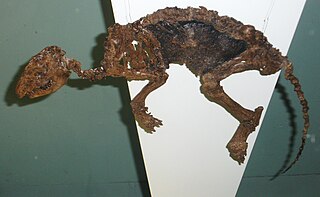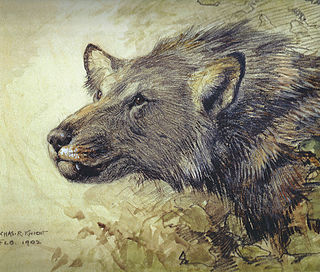
Castoridae is a family of rodents that contains the two living species of beavers and their fossil relatives. A formerly diverse group, only a single genus is extant today, Castor. Two other genera of "giant beavers", Castoroides and Trogontherium, became extinct in the Late Pleistocene.

The parvorder Catarrhini consists of the Cercopithecoidea and apes (Hominoidea). In 1812, Geoffroy grouped those two groups together and established the name Catarrhini, "Old World monkeys",. Its sister in the infraorder Simiiformes is the parvorder Platyrrhini. There has been some resistance to directly designate apes as monkeys despite the scientific evidence, so "Old World monkey" may be taken to mean the Cercopithecoidea or the Catarrhini. That apes are monkeys was already realized by Georges-Louis Leclerc, Comte de Buffon in the 18th century. Linnaeus placed this group in 1758 together with what we now recognise as the tarsiers and the New World monkeys, in a single genus "Simia". The Catarrhini are all native to Africa and Asia. Members of this parvorder are called catarrhines.

Pliopithecus is a genus of extinct primates of the Miocene. It was discovered in 1837 by Édouard Lartet (1801–1871) in France, with fossils subsequently discovered in Switzerland, Slovakia and Spain.
Macropoma is an extinct genus of coelacanth in the class Sarcopterygii. Fossils of Macropoma have been found in both England and Czech Republic, dating to the mid-Cretaceous (Albian-Turonian). Recorded fossils have bodies under two feet in length. A modern coelacanth measures five or more, but in other respects the two genera are remarkably similar, and share the same body plan with a three-lobed tail and stalked fins.

Ictitherium is an extinct genus belonging to the family Hyaenidae and the subfamily Ictitheriinae erected by Trouessart in 1897. Ictitherium species were endemic to Eurasia and Africa during the Middle Miocene through the Early Pliocene and existed approximately 7.4 million years.

Imagotaria is an extinct monotypic genus of walrus with the sole species Imagotaria downsi. Fossils of Imagotaria are known from the early late Miocene of California.

Rytiodus is an extinct genus of sirenian, whose fossils have been discovered in France, Europe and Libya.

Metridiochoerus is an extinct genus of swine known from the Pliocene and Pleistocene of Africa. It is also known as the giant warthog.

Dichobunidae is an extinct family of basal artiodactyl mammals from the early Eocene to late Oligocene of North America, Europe, and Asia. The Dichobunidae include some of the earliest known artiodactyls, such as Diacodexis.

Dendropithecus is an extinct genus of apes native to East Africa between 20 and 15 million years ago. Dendropithecus was originally suggested to be related to modern gibbons, based primarily on similarities in size, dentition, and skeletal adaptations. However, further studies have shown that Dendropithecus lacks derived hominoid traits. Instead, the traits shared between this taxon and modern primates are primitive for all catarrhines. Dendropithecus is now considered to be a stem catarrhine, too primitive to be closely related to any modern primates.
Borophagus parvus is an extinct species of the genus Borophagus, of the subfamily Borophaginae, a group of canids endemic to North America from the late Hemphillian of the Miocene epoch through the Pliocene epoch 10.3—4.9 Ma, existing for approximately 5.4 million years.

Borophagus hilli is an extinct species of the genus Borophagus of the subfamily Borophaginae, a group of canids endemic to North America from the Late Miocene until the Pliocene.

Borophagus diversidens is an extinct species of the genus Borophagus of the subfamily Borophaginae, a group of canids endemic to North America from the late Miocene epoch through the Pliocene epoch 4.9—1.8 Ma.

Borophagus littoralis is an extinct species of the genus Borophagus of the subfamily Borophaginae, a group of canids endemic to North America from the early Miocene epoch through the Pliocene epoch. Borophagus littoralis existed for approximately 18.4 million years.
Borophagus pugnator is an extinct species of the genus Borophagus of the subfamily Borophaginae, a group of canids endemic to North America from the early Miocene epoch through the late Miocene epoch 23.3—5.3 Ma. Borophagus pugnator existed for approximately 18 million years.

Pliopithecoidea is an extinct superfamily of catarrhine primates that inhabited Asia and Europe during the Miocene. Although they were once a widespread and diverse group of primates, the pliopithecoids have no living descendants.
Crouzeliinae is an extinct subfamily of Pliopithecidae primates that inhabited Europe and China during the Miocene, approximately 8–14.5 million years ago - they appear to have originated in Asia and extended their range into Europe between 17 and 13 million years ago. Crouzeliines can be distinguished from the other Pliopithecoidea subfamilies on the basis of uniquely derived dental traits.
Dionysopithecidae is an extinct family of fossil catarrhines and the earliest-known and most primitive members of the Pliopithecoidea superfamily, with fossils in Sihong in China dating to 18–17 million years ago for species Dionysopithecus shuangouensis and Platodontopithecus jianghuaiensis.
Propliopithecoidea is a superfamily of catarrhine primates that inhabited Africa and the Arabian Peninsula during the Early Oligocene about 32 to 29 million years ago. Fossils have been found in Egypt, Oman and Angola. They are one of the earliest known families of catarrhines.

Homacodontidae is an extinct family of basal artiodactyl mammals from the early Eocene to late Oligocene of North America, Europe, and Asia.


















